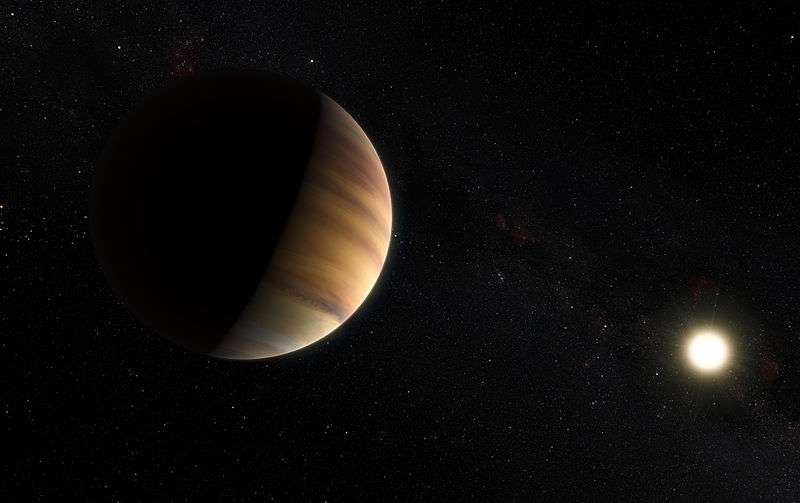February 1, 2017 report
Water detected in the atmosphere of hot Jupiter exoplanet 51 Pegasi b

(Phys.org)—Astronomers have detected the presence of water molecules in the atmosphere of a nearby hot Jupiter exoplanet known as 51 Pegasi b (51 Peb b for short). The discovery sheds new light on the nature of the exoworld's atmosphere and indicates that the star-planet system is a double-lined spectroscopic binary. The findings were presented Jan. 25 in a paper published on arXiv.org.
Located some 50 light years away, 51 Pegasi b is the first exoplanet discovered orbiting a main-sequence star and the first known hot Jupiter. It was classified as a hot Jupiter because it has orbital period of less than 10 days (4.23 days) and is similar in characteristics to the solar system's biggest planet, with a mass of about 0.47 Jupiter masses. It has high surface temperature, as it orbits its parent star 51 Pegasi very closely—at a distance of about 0.05 AU.
To better characterize this planetary system, a team of astronomers led by Jayne Birkby have observed 51 Pegasi and its planet with the CRyogenic high-resolution InfraRed Echelle Spectrograph (CRIRES) at the Very Large Telescope (VLT) in Chile. They obtained a total of 42 spectra allowing them to observe the radial-velocity shift of the water features in the planet's day side atmosphere.
"We have presented a 5,6σ detection of water molecules in the atmosphere of the original hot Jupiter, 51 Peg b, providing the first confirmation that the 51 Peg Ab system is a double-lined spectroscopic binary. (…) The best-matching model to the planet spectra from our grid contained molecular features from water only, with a volume mixing ratio of VMRH2O = 104," the researchers wrote in the paper.
According to the team, the direct detection of water absorption lines in the spectrum of the planet's atmosphere that undergo a change in Doppler shift provides important insights on the nature of this planetary system. In particular, this shows the true binary nature of this star-planet system, revealing it to be a double-lined spectroscopic (non-eclipsing) binary.
Besides water, the researchers also searched for molecular features arising from the expected major carbon- and oxygen-bearing gases at the observed wavelengths, like water carbon dioxide and methane. However, they found no significant signal from these molecules that would indicate their presence at the abundances probed by their model grid in the atmosphere of 51 Pegasi b.
"We detected no methane or carbon dioxide at a significant level in our observations, indicating a low abundance, or possibly inaccuracies in the line lists we used to create the model templates," the paper reads. Moreover, the team also noted that an upper limit to the rotational velocity of 51 Pegasi b should be less than 5.8 km s-1. However, instruments with higher resolution are required to confirm if the planet's rotation is tidally locked to its host star.
"Finally, we concluded that further optical observations of 51 Peg b would enable an independent orbital solution in reflected light, and if this resulted in a significantly different planet systemic velocity from the infrared observations, that an offset hot spot in the atmosphere may be needed to explain the infrared measurements," the scientists wrote in the paper.
More information: Discovery of water at high spectral resolution in the atmosphere of 51 Peg b, arXiv:1701.07257 [astro-ph.EP] arxiv.org/abs/1701.07257
Abstract
We report the detection of water absorption features in the dayside spectrum of the first-known hot Jupiter, 51 Peg b, confirming the star-planet system to be a double-lined spectroscopic binary. We used high-resolution (R~100,000), 3.2 micron spectra taken with CRIRES/VLT to trace the radial-velocity shift of the water features in the planet's dayside atmosphere during 4 hours of its 4.23-day orbit after superior conjunction. We detect the signature of molecular absorption by water at a significance of 5.6 sigma at a systemic velocity of Vsys=-33+/-2 km/s, coincident with the host star, with a corresponding orbital velocity Kp = 133^+4.3_-3.5 km/s. This translates directly to a planet mass of Mp=0.476^+0.032_-0.031MJ, placing it at the transition boundary between Jovian and Neptunian worlds. We determine upper and lower limits on the orbital inclination of the system of 70 < i (deg) < 82.2. We also provide an updated orbital solution for 51 Peg b, using an extensive set of 639 stellar radial velocities measured between 1994 and 2013, finding no significant evidence of an eccentric orbit. We find no evidence of significant absorption or emission from other major carbon-bearing molecules of the planet, including methane and carbon dioxide. The atmosphere is non-inverted in the temperature-pressure region probed by these observations. The deepest absorption lines reach an observed relative contrast of 0.9x10^-3 with respect to the host star continuum flux, at an angular separation of 3 milliarcseconds. This work is consistent with a previous tentative report of K-band molecular absorption for 51 Peg b by Brogi et al. (2013).
© 2017 Phys.org




















